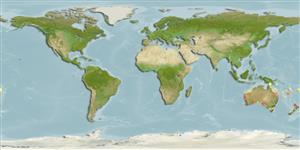Actinopterygii (ray-finned fishes) >
Perciformes (Perch-likes) >
Cheilodactylidae (Morwongs)
Etymology: Cheilodactylus: Greek, cheilos = lip + Greek, daktylos = finger (Ref. 45335). More on author: Castelnau.
Environment / Climate / Range
Ecology
Marine; reef-associated; depth range ? - 30 m (Ref. 9002). Temperate, preferred ?
Western Pacific: eastern Australia and northeastern New Zealand.
Size / Weight / Age
Maturity: Lm ? range ? - ? cm
Max length : 65.0 cm TL male/unsexed; (Ref. 9002)
Adults found on exposed rocky reefs down to about 30 m; juveniles on coastal reefs, amongst algae.
Life cycle and mating behavior
Maturity | Reproduction | Spawning | Eggs | Fecundity | Larvae
Hoese, D.F., D.J. Bray, J.R. Paxton and G.R. Allen, 2006. Fishes. In Beasley, O.L. and A. Wells (eds.) Zoological Catalogue of Australia. Volume 35.2 Australia: ABRS & CSIRO Publishing, 1472 p. (Ref. 75154)
IUCN Red List Status (Ref. 115185)
CITES (Ref. 94142)
Not Evaluated
Threat to humans
Harmless
Human uses
More information
Common namesSynonymsMetabolismPredatorsEcotoxicologyReproductionMaturitySpawningFecundityEggsEgg development
ReferencesAquacultureAquaculture profileStrainsGeneticsAllele frequenciesHeritabilityDiseasesProcessingMass conversion
Tools
Special reports
Download XML
Internet sources
Estimates of some properties based on models
Phylogenetic diversity index (Ref.
82805): PD
50 = 0.5000 [Uniqueness, from 0.5 = low to 2.0 = high].
Bayesian length-weight: a=0.01202 (0.00543 - 0.02660), b=3.02 (2.82 - 3.22), in cm Total Length, based on LWR estimates for this (Sub)family-body shape (Ref.
93245).
Trophic Level (Ref.
69278): 2.8 ±0.26 se; Based on food items.
Resilience (Ref.
69278): Low, minimum population doubling time 4.5 - 14 years (Preliminary K or Fecundity.).
Vulnerability (Ref.
59153): High vulnerability (58 of 100) .
